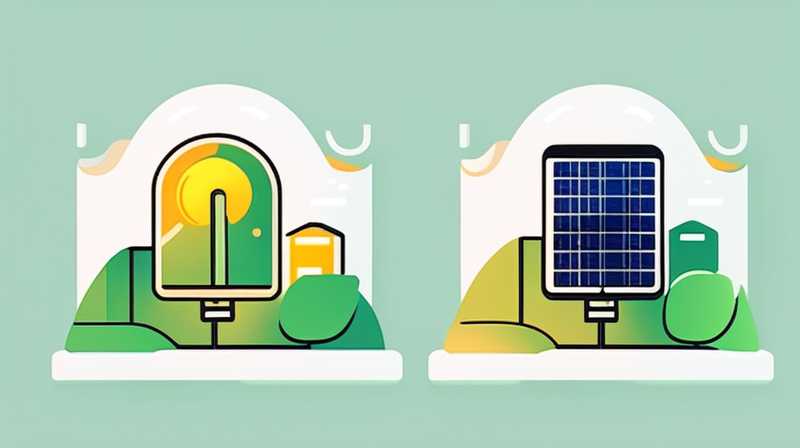
1. Understanding Solar Smart Lights
Using solar smart lights effectively requires an understanding of their components and how they operate. It is essential to recognize the advantage of energy efficiency, cost savings, and their environmental benefits. These lights harness solar energy, converting it into electricity through photovoltaic panels. The energy generated charges the built-in batteries, providing illumination during nighttime without consuming grid electricity.
2. Types of Solar Smart Lights
Various types of solar smart lights exist, suited for different applications and preferences. Outdoor solar lights, decorative solar fixtures, and security solar lights cater to diverse lighting needs. Outdoor solar lights offer functional illumination along pathways or gardens, enhancing safety. Decorative solar fixtures, such as lanterns or string lights, add aesthetic value to outdoor spaces. Meanwhile, security solar lights serve a dual purpose, providing illumination while deterring potential intruders.
3. Installation and Positioning
To maximize efficiency, proper installation and positioning are critical. Selecting an optimal location with ample sunlight exposure drastically increases charging efficiency. Placement should avoid shadows from trees, buildings, or other structures that could obstruct sunlight throughout the day. Mounting height also influences functionality; for motion sensor lights, a height of 6 to 10 feet ensures effective detection while providing adequate illumination coverage.
4. Maintenance Practices
To ensure prolonged performance, routine maintenance is necessary. Cleaning the solar panels periodically removes dirt and debris, preventing diminished charging capacity. Additionally, checking the batteries for functionality ensures lights operate efficiently, even on cloudy days. Consider replacing batteries once a year to keep the lights in peak condition, as their performance decreases over time.
5. Advanced Features of Solar Smart Lights
Many solar smart lights now come equipped with advanced features, making them even more user-friendly. Light sensors, motion detectors, and smart connectivity options enhance their efficiency and convenience. Light sensors automatically adjust brightness according to available daylight, while motion detectors activate lights based on movement, saving energy. Some smart lights even integrate with mobile applications, enabling control and monitoring from smartphones.
6. Environmental Impact of Solar Smart Lights
Investing in solar smart lights contributes to environmental conservation. By reducing reliance on fossil fuels and lowering carbon footprints, these lights promote greener living. Through harnessing renewable energy, solar smart lights reduce energy consumption, which is vital in combating climate change. Their widespread adoption can significantly aid in creating sustainable communities, aligning with global energy transition goals.
7. Understanding Economic Benefits
The financial advantages of utilizing solar smart lights are significant. While the initial investment may seem higher than traditional lighting, the long-term savings on electricity bills can be substantial. With no wiring or installation costs, and the absence of ongoing energy expenses, the adoption of solar smart lights becomes increasingly attractive for homeowners and businesses alike.
8. Social Advantages of Solar Smart Lights
Social benefits stem from installing solar smart lights in communities. Improved safety and aesthetics promote a sense of security and community pride. Well-lit pathways and public areas invite increased foot traffic and encourage nighttime social activities, fostering community connections. Moreover, neighborhoods united in their commitment to sustainability create a positive image, attracting interest and potential investment.
9. Future Prospects of Solar Smart Technology
As technology evolves, the future of solar smart lights looks promising. Emerging innovations include integration with smart city infrastructure and enhanced energy storage solutions. These developments signify a shift towards more intelligent, grid-independent lighting systems that can adapt to changing environmental conditions and user demands.
FAQS
WHAT ARE SOLAR SMART LIGHTS?
Solar smart lights are outdoor lighting fixtures that harness solar energy for operation. These lights incorporate photovoltaic cells that capture sunlight, converting it into electricity stored in built-in batteries. By utilizing renewable energy, solar smart lights provide illumination without reliance on conventional electric grids. They come equipped with sensory technology that adjusts brightness levels based on ambient light, ensuring efficient energy use. Additionally, many models feature connectivity options that allow users to control and monitor the lights via mobile apps. This combination of convenience, efficiency, and sustainability makes solar smart lights a popular choice for enhancing outdoor spaces.
HOW DO I INSTALL SOLAR SMART LIGHTS?
To install solar smart lights, begin by selecting an ideal location that receives ample sunlight throughout the day. Look for areas free from shadows cast by trees or structures that could inhibit solar charging. When mounting the lights, ensure they are positioned at an appropriate height, typically between 6 to 10 feet, especially for security lights that utilize motion sensors. Follow the manufacturer’s instructions, which may include securing fixtures to poles or walls using screws or brackets. Finally, test the lights after installation to ensure proper functioning and optimal light sensitivity. Proper installation sets the foundation for effective lighting and energy efficiency.
HOW OFTEN SHOULD I CLEAN MY SOLAR SMART LIGHTS?
Cleaning solar smart lights is essential for maintaining their performance and efficiency. Ideally, inspect the lights every few months to assess buildup on the solar panels. Environmental factors, such as dust, pollen, or debris, can accumulate over time, obstructing sunlight absorption. If significant dirt is present, gently wipe the solar panels with a soft, damp cloth. Ensure no abrasive materials are used, as they could scratch the surface. Regular maintenance not only enhances charging capability but also extends the lifespan of the lights, ensuring they remain an effective lighting solution for years to come.
Utilizing solar smart lights offers an innovative approach to outdoor lighting, blending convenience, environmental sustainability, and energy savings into one package. By understanding their operation and features, and adhering to proper installation and maintenance protocols, users can maximize their benefits and contribute positively to green living. As technology progresses, the adaptability and functionality of these lights will continue to evolve, leading to a brighter, more sustainable future.
Original article by NenPower, If reposted, please credit the source: https://nenpower.com/blog/how-to-use-electricity-with-solar-smart-lights/


